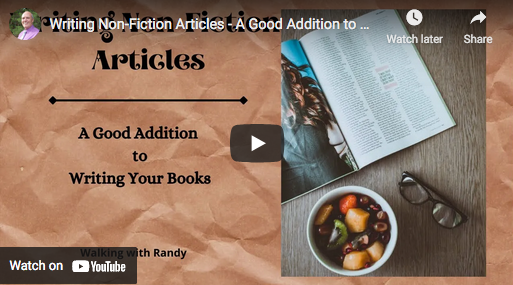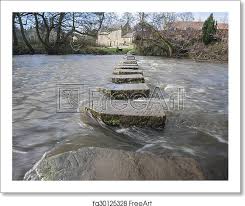Janet was walking along and saw the edge of the cliff. Then her right foot slipped! She didn’t regain her balance, and she slipped over the edge She began to slide down the slope. She grabbed a branch and was hanging on for dear life.
How does that relate to your article or chapter? It may not relate at all. But if it did, you would surely have everyone’s attention. Let’s talk about four nonfiction writing techniques.
Narrative Items
First, you can use narrative items. Tell a story. The story can still be a true story, so you would still be writing non-fiction. You can also invent a story. In that case, you would be adding some fiction in with your non-fiction writing. At any rate, you can use storytelling or narrative techniques.
You can do that in the form of an illustration. After all, who doesn’t love a good story?
Another thing you can do is use the story arc to develop your material. You would have to do a little more research on what the story arc is, but it’s something you can do. Basically, you have a beginning, middle, and end. You have a problem, then a conflict, then escalating problems, and then solving the conflict. You can set up non-fiction writing in a similar manner.

Another place you can use that technique is in the introduction. You can use narratives in the introduction just like I did with the fictional story of Janet and the cliff. Or you can use a personal or historical story as you go about doing that.
A couple of other techniques that aren’t necessarily narrative in the introduction is asking a question or questions. You may be trying to solve a problem anyway, so you may want to restate that problem in the form of a question.
Another technique you can use in the introduction is interesting, unique, or funny thoughts at the beginning of your writing
So use narrative techniques.
Details, Details, Details

Also, use details. Sometimes, you need to have some details just to help with the clarity of your writing. You can also add sensory details. Talk about the smell, or sound, or the sounds in the setting. Use those sensory details. Sometimes, those sensory details relate to emotions. If you are involved in sales, many people tell you that people buy from emotions as well as from want. So use sensory details. Add emotional triggers where that’s appropriate to do so.
This is the second technique.
Keep it Simple
Third, use simplicity. Abraham Lincoln said if you have the choice between a simple word and a complex word, and the simple word will convey the proper idea, use the simple word. That was good advice coming from our 16th president. Use short or clear words where you can.
Use short paragraphs. One of the ways to use shorter paragraphs may be contrary to what you were once taught in school. In the old way of writing books, you may have had 2-3 long paragraphs per page. One of those paragraphs may have included five items within that paragraph. And that is a proper way of doing that. You would have a topic sentence, then you would enumerate the 5 items, and you may have a clincher sentence at the end.
The more modern way of doing that is to make that 5 paragraphs and have the topic sentence in the first paragraph with the first point, and the second item would be the second paragraph, third- third paragraph, fourth- fourth paragraph, and fifth – fifth paragraph. Or, you may have six paragraphs, with the topic sentence being a paragraph on its own, introducing that topic. You may even make it seven paragraphs, having a “clincher” paragraph/sentence at the end.
You’ll notice in a lot of online writing, a lot of blogs, and a lot of areas where you observe writing techniques, you’ll notice in modern-day copywriting, there is a lot of “white space,” or there is a line between the paragraphs, which gives more white space. That is if you have black letters on white paper, which is how it’s usually done.
So, use simplicity. Use short paragraphs and short, clear words, and white space where possible.
Variety is the Spice of Life
The last technique is to use variety. You can use variety in sentence lengths. I know I said to use short sentences, but don’t use only short sentences. If you do that, they will be like little bullets one right after the other. So you want some variety in sentence length. Many of them will be shorter because you made a conscious effort to do that, but some should be longer so you have variety.
Also, use variety in the sentence types. You have simple sentences, you have compound sentences, and even compound-complex sentences. You may want to use several short sentences, but for variety, you should throw in compound, and compound-complex sentences. Use variety in sentence length and types.

Another thing you can do is use variety in points of view. If you are using stories, either fiction or nonfiction, to illustrate your points, you can tell them from the first-person point of view. You may have been talking about something that was a personal experience. In that case, you would say, “I did this. I did that.”
Another story may relate to someone else and you may speak about that in the third person. Sometimes, you can tell a story about someone else, and you can tell it as though you are that character. You should make clear to your reader that you are not that character, but you can tell it in first-person.
If you’re writing conversationally, many of your sentences will be the second-person point of view where you’re addressing the reader as “you.” Or you could do a third-person point of view.
Think of each story as a scene in a movie. You just don’t want to change the point of view within the scene or illustration. The first story may be from the first-person point of view, and the next may be a third-person point of view. Just don’t mix the two within the same illustration.
In Summary
These are some nonfiction writing techniques that can make your chapters or articles more interesting.
1. Use narrative items.
2. Use details.
3. Use simplicity.
4. Use variety.
For more writing tips, head to Randy’s Blogs. On the top of the page, you’ll find a heading labeled “writing”. There is a lot of helpful information there. This article relates to the idea of steps to writing success.
To get even more help and advice, check out my book, ” How to Write a Book in 28 Days Without Stressing Yourself to Death”. Just go to Amazon.com, type in the full title in the search bar, and you’ll be able to purchase either an eBook or a print book. ( Note, the book is officially launching in November, 2021. I encourage you to participate in the launch. There will be some perks during the launch.)
I hope this has been helpful for you. Happy writing!








